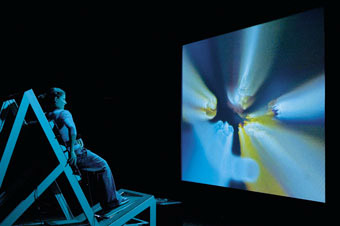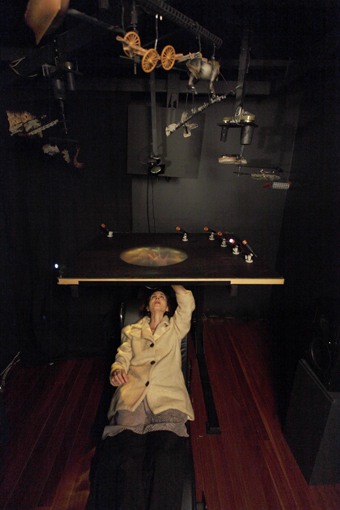returning time to the future
lisa gye: interview, new media artist keith armstrong

transmute collective, Intimate Transactions (2005)
photo David McLeod
transmute collective, Intimate Transactions (2005)
FINITUDE (V2) BY KEITH ARMSTRONG IS A TOUCH-SENSITIVE INTERACTIVE INSTALLATION COMBINING 3D IMAGERY, TRANSPARENCY, MOVING SCULPTURE, LIGHT AND SOUND. IT INVESTIGATES THE CULTURAL DIMENSIONS OF SUSTAINABILITY THROUGH THE LENS OF ‘TIME’ AND HAS SHOWN AT (M) ART AND GALLERY ARTISAN IN BRISBANE’S FORTITUDE VALLEY.
Armstrong has just returned from handing over an earlier work, Intimate Transactions, to Germany’s ZKM (Centre for Art and Media) who have acquired it for their permanent collection. I spoke with him about the handover and about the new work, Finitude.
What are some of the issues/challenges that have arisen through this process of acquisition—particularly in terms of how the work is installed and then invigilated by staff at the museum? How does ZKM propose that the work is maintained and do you have any responsibility for that?
I guess I’d expected that finding a home for such a beast would be no easy feat. I should probably explain what Intimate Transactions is for those who may not have experienced it. In essence, it is an experimental form of telepresence-based interactive installation that allows two people in geographically separate spaces to interact simultaneously using only their bodies. Each participant uses a physical interface called a “Bodyshelf” and wears a sound vibration transmission device around their necks called a “haptic pendant.” By gently moving their bodies on this ‘smart furniture,’ they instigate ‘intimate transactions,’ which influence an evolving ‘world’ created from digital imagery, multichannel sound and tactile feedback. This conjoint individual and shared experience allows each participant to gradually develop a form of sensory intimacy with the other, despite the fact that they are geographically separated and cannot physically see or hear each other.
I was familiar with ZKM and its ambition, having visited it when Jeffrey Shaw was at the helm well over a decade ago. I knew Peter (Weibel) had taken over and that the museum held significant examples of work in the genre of telepresence, alternate interface experiments and performative inflected experience. Examples are Paul Sermon’s Telematic Vision (1993) and Tables Turned (1997) or Masaki Fujihata’s Impressing Velocity (with Simulation Platform) (1994-99)—all works that had some influence on our piece.So I approached him and he was positive because I guess he could also sense the links and resonances.
I spent a full week working with their team in Karlsruhe, Germany, which included some very experienced and fast working technicians, a team of conservators, IT specialists and a range of administrative staff. My key role was to take them through every stage of the work: unpack, install, assembly, testing, running and the performative processes that surround it. And as we went through it each day they documented each stage exhaustively and with great enthusiasm! They also worked out a great deal of how it went together which is testament to their experience as world leaders. I then handed over the complete documentation archive for the work which includes a 135-page book edited by Jillian Hamilton and the full gamut of CAD models, plans, schematics, code, images, documentation of each site and setup and running instructions.
I then did a two-hour recorded interview with the conservators and they asked me questions about how it should be presented, maintained and conserved—going through everything down to the details of where electronics modules could be bought and what specifications of hardware would be needed in the event of failure. So they now own the work and can access the requisite IP, and it can be shown either at ZKM in the Media Museum or lent out to international galleries. I am not directly responsible for maintenance, although of course I’d be on hand and willing to assist at any stage.

Finitude, Keith Armstrong
photo Carl Warner
Finitude, Keith Armstrong
It is interesting that your works are themselves like the complex ecosystems that seem to inspire your practice generally; and that the difficulty in maintaining the works themselves seems to add a layer of meta commentary to them, in the sense that they are both about questions of sustainability and that they invoke their own issues in regards to sustainability. Could you comment on this in relation to your latest work, Finitude?
I think it was Fritjof Capra who once said that for systems thinkers the relationships are primary. Thinking back to my earliest training as a systems engineer, I realise that what has always driven me is the exploration of the systemic and the relational. Initially I believed that the role of my works could be to examine and maybe illuminate how much we have misunderstood ecology. But then I began to see that simply raising awareness was quite a different motivation from moving through an embodying of that knowledge towards forms of learning: we ‘know’ much but what have we ‘learnt?’ The works I have created over the past two decades are, as you suggest, a working through—invoking your “meta commentary” idea. Privileging that relational approach often ensured ‘impracticalities.’ The tacit requirements for work to be hangable, to be low labour when showing or able to be packed into suitcases for transit, haven’t been ‘keystone’ aspects of my thinking to date. This conflates with the ‘education in error’ that we have all received, our education into unsustainability. We often think our way through things technologically in ways that may exclude as well as include. These things add up, as relationship-building factors that in part conspire to elicit such paradoxes.
The challenge I face with every new work is which path to take. Pragmatism is all around us in our politics and our culture. But despite its short-term attraction it’s also a profoundly limiting force. And so it can be in media art too. I’ve also become used to many people spending maybe 15 minutes or more with my works. I like that power for temporal engagement which most artwork that is seen and not experienced in a literal or embodied sense can rarely muster. So while Finitude represents a much easier system to show and maintain than Intimate Transactions, there are the relative problematics of one-at-a-time operation, the physical requirement to get in underneath the work (requiring a hanging structure), the experimentation with relatively new forms of self-made touch screen and special new screen materials, new software to connect to 3D engines and the like. These all add up and also extend the making process, but the outcome I think then really surprises and offers something that truly imprints! I started with a reasonably distilled idea—time has become finitude—that is, ‘time left’ for us and many other species is literally running out, so how might we give time back to the future? Combined with strong thematics derived from residencies in the Australian mallee heartlands, we created an outcome that honoured embodied exchange, deep engagement, time to settle and multi-sensorial qualities that took much time and probably shortened my ‘time left!’ On that note Paul Carter experienced the work at the Mildura Palimpsest last year (his timely book Ground Truthing: Explorations in a Creative Region [UWA Publishing, 2010], inspired the work) and very sweetly noted that I had “somehow made sense from his incoherent ramblings.”
Both Intimate Transactions and Finitude are much more about process than product. Your references to “embodied exchange, deep engagement, time to settle” are indicative of this dynamic quality of the works. While the ‘machinery’ of the works can be stored and reactivated, it is harder to capture (and hence evaluate and archive) the effect that they have on those who engage with them. How do you deal with this, or do you?
Each is a tangible work/event that requires audience durational attention: and in that way they have the conventionality of a recognisable practice. The works in themselves are really for me catalysts for, or openings out to, something quite different from how they initially appear. Obviously, this effect is something I can’t directly control or therefore even re-create.
Many will take these works for what they seem to be, with all of the hooks, immersion and problematics that come with both eco-theoretical and technological possibility-imbued experience and interfaces. But if you dig a little deeper, see the pointers, maybe think more about the ecosophical intentions, I’d hope they might catalyse a journey for some, a relational journey for their own time and place and context. This is where new knowledges, I believe, can emerge through practice and become embodied and therefore get their teeth.
This openness to the best possibilities is concurrent with my current thinking and recent collaborations, typified by our NBN-based project, Long Time No See, or my forthcoming ANAT-Synapse Residency, Reintroduction, with the Australian Wildlife Conservancy. These new research ventures have emerged from experience around our recent Remnant Emergency Artlab collaborations that have taken my practice into a relationship with the rich new territories of urban planning, mammal ecology, speculative architecture, experimental engineering and ‘ontological design,’ among others. And so, while I have always felt passionately directed, these are daunting but exciting times ahead in this practice of intentional eclecticism!
Finitude (v2) by Keith Armstrong, collaborators Roger Dean, Stuart Lawson, Darren Pack, consultants Professor Tony Fry and Dr Liz Baker; Artisan, Brisbane, April 12-June 9; www.embodiedmedia.com
Keith Armstrong and Gavin Sade were recently awarded one of the Australia Council Broadband Arts Initiative grants for the project Long Time No See which will involve an installation and online presence exploring a range of community responses to questions around what the nation might look like, not just a few decades, but a few centuries into the future. The work will be based at The Cube, QUT’s new Science and Engineering Centre.
RealTime issue #109 June-July 2012 pg. 18






